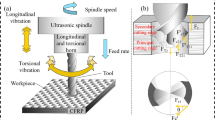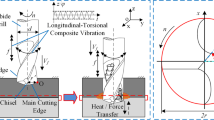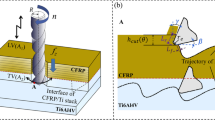Abstract
Ultrasonic vibration–assisted core drilling has achieved some beneficial results in carbon fiber–reinforced plastics (CFRP) hole machining. Among them, longitudinal-torsional ultrasonic-assisted core drilling (LTUACD) shows more significant advantages in decreasing cutting force and reducing delamination defects and other aspects compared to longitudinal ultrasonic-assisted core drilling (LUACD). However, the reduction mechanism of cutting force and delamination defects in LTUACD is still not clear enough. Therefore, this paper researched the machining performance of LTUACD of CFRP. Specifically, the cutting force in LTUACD of CFRP is analyzed based on hertz contact theory and indentation depth theory. Then, a series of experiments were conducted to verify the analysis. And delamination suppression mechanism was discussed from the aspects of surface morphology of hole wall, exit morphology of hole, and bottom surface morphology of blind hole. The results show that the cutting force is significantly reduced in LTUACD compared to conventional core drilling (CCD) and LUACD due to the additional torsional vibration of tool, which changes the contact state between abrasive grain and material. Therefore, the exit delamination is further suppressed. In addition, the adhesion phenomenon of chips on the tool is also reduced, which enhances the tool cutting ability to obtain even fiber fracture surfaces and greatly improves hole quality.

















Similar content being viewed by others
References
Geng D, Liu Y, Shao Z, Zhang M, Jiang X, Zhang D (2019) Delamination formation and suppression during rotary ultrasonic elliptical machining of CFRP. Compos B Eng 183:107698. https://doi.org/10.1016/j.compositesb.2019.107698
Li Y, Jiao F, Zhang Z, Feng Z, Niu Y (2022) Research on entrance delamination characteristics and damage suppression strategy in drilling CFRP/Ti6Al4V stacks. J Manuf Process 76:518–531. https://doi.org/10.1016/j.jmapro.2022.02.018
Wu CQ, Gao GL, Li HN, Luo H (2019) Effects of machining conditions on the hole wall delamination in both conventional and ultrasonic-assisted CFRP drilling. Int J Adv Manuf Technol 104(5–8):2301–2315. https://doi.org/10.1007/s00170-019-04052-y
Gemi L, Morkavuk S, Köklü U, Gemi D (2019) An experimental study on the effects of various drill types on drilling performance of GFRP composite pipes and damage formation. Compos B Eng 172:186–194. https://doi.org/10.1016/j.compositesb.2019.05.023
Tsao CC, Hocheng H (2004) Taguchi analysis of delamination associated with various drill bits in drilling of composite material. Int J Mach Tool Manu 44(10):1085–1090. https://doi.org/10.1016/j.ijmachtools.2004.02.019
Cadorin N, Zitoune R (2015) Wear signature on hole defects as a function of cutting tool material for drilling 3D interlock composite. Wear 332–333:742–751. https://doi.org/10.1016/j.wear.2015.01.019
Cong WL, Pei ZJ, Treadwell C (2014) Preliminary study on rotary ultrasonic machining of CFRP/Ti stacks. Ultrasonics 54(6):1594–1602. https://doi.org/10.1016/j.ultras.2014.03.012
Feng Q, Cong WL, Pei ZJ, Ren CZ (2012) Rotary ultrasonic machining of carbon fiber-reinforced polymer: feasibility study. Mach Sci Technol 16(3):380–398. https://doi.org/10.1080/10910344.2012.698962
Zhang D, Wang H, Burks AR, Cong W (2020) Delamination in rotary ultrasonic machining of CFRP composites: finite element analysis and experimental implementation. Int J Adv Manuf Technol 107(9–10):3847–3858. https://doi.org/10.1007/s00170-020-05310-0
Lv D, Chen M, Yao Y, Yan C, Chen G, Zhu Y (2021) High-frequency vibration effects on the hole integrity in rotary ultrasonic drilling of carbon fiber-reinforced plastic composites. Ultrasonics 115:106448. https://doi.org/10.1016/j.ultras.2021.106448
Ning F, Wang H, Cong W (2019) Rotary ultrasonic machining of carbon fiber reinforced plastic composites: a study on fiber material removal mechanism through single-grain scratching. Int J Adv Manuf Technol 103(1–4):1095–1104. https://doi.org/10.1007/s00170-019-03433-7
Baraheni M, Amini S (2019) Comprehensive optimization of process parameters in rotary ultrasonic drilling of CFRP aimed at minimizing delamination. Int J Lightweight Mater Manuf 2(4):379–387. https://doi.org/10.1016/j.ijlmm.2019.03.003
Thirumalai Kumaran S, Ko TJ, Li C, Yu Z, Uthayakumar M (2016) Rotary ultrasonic machining of woven CFRP composite in a cryogenic environment. J Alloy Compo 698:984–993. https://doi.org/10.1016/j.jallcom.2016.12.275
Shi H, Yuan S, Li Z, Song H, Qian J (2019) Evaluation of surface roughness based on sampling array for rotary ultrasonic machining of carbon fiber reinforced polymer composites. Measurement 138:175–181. https://doi.org/10.1016/j.measurement.2019.02.002
Li Z, Zhang D, Qin W, Geng D (2016) Removal analyses of chip and rod in rotary ultrasonic-assisted drilling of carbon fiber-reinforced plastics using core drill. J Reinf Plast Comp 35(15):1173–1190. https://doi.org/10.1177/0731684416644510
Amini S, Baraheni M, Mardiha A (2018) Parametric investigation of rotary ultrasonic drilling of carbon fiber reinforced plastics. Proc Inst Mech Eng Part E 232(5):540–554. https://doi.org/10.1177/0954408917727199
Chen F, Bie W, Wang X, Zhao B (2022) Longitudinal-torsional coupled rotary ultrasonic machining of ZrO2 ceramics: an experimental study. Ceram Int 48(19):28154–28162. https://doi.org/10.1016/j.ceramint.2022.05.398
Wang J, Zhang J, Feng P, Guo P, Zhang Q (2018) Feasibility study of longitudinal–torsional-coupled rotary ultrasonic machining of brittle material. J Manuf Sci Eng 140(5):051008. https://doi.org/10.1115/1.4038728
Geng D, Zhang D, Xu Y, He F, Liu F (2014) Comparison of drill wear mechanism between rotary ultrasonic elliptical machining and conventional drilling of CFRP. J Reinf Plast Comp 33(9):797–809. https://doi.org/10.1177/0731684413518619
Liu J, Zhang D, Qin L, Yan L (2011) Feasibility study of the rotary ultrasonic elliptical machining of carbon fiber reinforced plastics (CFRP). Int J Mach Tool Manu 53(1):141–150. https://doi.org/10.1016/j.ijmachtools.2011.10.007
Geng D, Lu Z, Yao G, Liu J, Li Z, Zhang D (2017) Cutting temperature and resulting influence on machining performance in rotary ultrasonic elliptical machining of thick CFRP. Int J Mach Tool Manu 123:160–170. https://doi.org/10.1016/j.ijmachtools.2017.08.008
Cong WL, Pei ZJ, Sun X, Zhang C (2013) Rotary ultrasonic machining of CFRP: a mechanistic predictive model for cutting force. Ultrasonics 54(2):663–675. https://doi.org/10.1016/j.ultras.2013.09.005
Chen M, Zhao Q, Dong S, Li D (2004) The critical conditions of brittle–ductile transition and the factors influencing the surface quality of brittle materials in ultra-precision grinding. J Mater Process Tech 168(1):75–82. https://doi.org/10.1016/j.jmatprotec.2004.11.002
Lu Y, Yuan S, Chen Y (2019) A cutting force model based on kinematic analysis in longitudinal and torsional ultrasonic vibration drilling. Int J Adv Manuf Technol 104(1–4):631–643. https://doi.org/10.1007/s00170-019-03884-y
Faraz A, Biermann D, Weinert K (2009) Cutting edge rounding: an innovative tool wear criterion in drilling CFRP composite laminates. Int J Mach Tool Manu 49(15):1185–1196. https://doi.org/10.1016/j.ijmachtools.2009.08.002
Wang J, Feng P, Zhang J, Shen H (2017) Experimental investigation on the effects of thermomechanical loading on the vibrational stability during rotary ultrasonic machining. Mach Sci Tech 21(2):239–256. https://doi.org/10.1080/10910344.2017.1283962
Geng D, Teng Y, Liu Y, Shao Z, Jiang X, Zhang D (2019) Experimental study on drilling load and hole quality during rotary ultrasonic helical machining of small-diameter CFRP holes. J Mater Process Tech 270:195–205. https://doi.org/10.1016/j.jmatprotec.2019.03.001
Krishnaraj V, Prabukarthi A, Ramanathan A, Elanghovan N, Senthil Kumar M, Zitoune R, Davim JP (2012) Optimization of machining parameters at high speed drilling of carbon fiber reinforced plastic (CFRP) laminates. Compos B Eng 43(4):1791–1799. https://doi.org/10.1016/j.compositesb.2012.01.007
Funding
The research is supported financially by National Natural Science Foundation of China (No. 51675164) and Fundamental Research Funds for the Universities of Henan Province (No. NSFRF200102).
Author information
Authors and Affiliations
Contributions
ZiQiang Zhang: conceptualization, methodology, data analysis, software, writing—original draft. Feng Jiao: conceptualization; methodology; writing—review; editing—manuscript; funding acquisition; supervision. Yuanxiao Li: data collection, investigation, software. Ying Niu: material preparation, software, supervision. Jinglin Tong: experiment design, investigation, resources.
Corresponding author
Ethics declarations
Ethical approval
Not applicable.
Consent to participate
Not applicable.
Consent for publication
Not applicable.
Conflict of interests
The authors declare no competing interests.
Additional information
Publisher's note
Springer Nature remains neutral with regard to jurisdictional claims in published maps and institutional affiliations.
Rights and permissions
Springer Nature or its licensor (e.g. a society or other partner) holds exclusive rights to this article under a publishing agreement with the author(s) or other rightsholder(s); author self-archiving of the accepted manuscript version of this article is solely governed by the terms of such publishing agreement and applicable law.
About this article
Cite this article
Zhang, Z., Jiao, F., Li, Y. et al. Machining performance in longitudinal-torsional ultrasonic-assisted core drilling of CFRP. Int J Adv Manuf Technol 131, 2001–2015 (2024). https://doi.org/10.1007/s00170-022-10560-1
Received:
Accepted:
Published:
Issue Date:
DOI: https://doi.org/10.1007/s00170-022-10560-1




